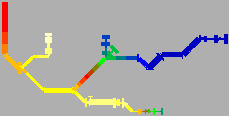General
Projects
Action Potential Propagation
This page describes my work on models of action potential propagation along branching axons. This work has been carried out in collaboration with Prof. Stephen Redman, Dr Bruce Walmsley and Dr Madeleine Nicol (John Curtin School of Medical Research, Australian National University, Canberra).
- Presynaptic Inhibition
- Propagation along Branching Axons
- Frequency Dependent Propagation
- References
- Background References
Presynaptic Inhibition
The initial work concerned the effect of presynaptic inhibition on action potential amplitude in boutons. The first models were of uniform axons containing hemispherical boutons (Graham and Redman, 1994). We then considered small, branching segments from a serial E-M reconstructed group Ia afferent collateral (Nicol and Walmsley, 1991, Walmsley et al, 1995). In both cases it was concluded that the effect of presynaptic inhibition on action potential amplitude was unlikely to be sufficient to significantly reduce transmitter release from the bouton. Thus the inhibition may work by other mechanisms, such as inactivating high threshold calcium channels.
Propagation along Branching Axons
A compartmental model of the entire reconstructed group Ia afferent has been used to investigate the effects of different channel densities and distributions on action potential propagation (Graham and Walmsley, 1994, Graham et al, 1996). The geometry of the collateral proved to be quite sensitive, so that a particular distribution of ion channels allowed propagation of the action potential to all axon terminals, while another, equally plausible, distribution resulted in the failure of the action potential to propagate into a particular branch.
Click here to see an MPEG movie (360Kbytes) of successful action potential propagation, and here to see a movie of branch point failure.
Frequency Dependent Propagation
Compartmental models of simple, inhomogeneous axons have been used to
investigate frequency-dependent propagation of trains of action
potentials (Graham, 1995, 1996).
Frequency-dependent effects were caused by extracellular
potassium accumulation. The axons acted as band-pass filters,
blocking low and high frequency trains of action potentials, while
allowing propagation of trains within a particular frequency range.
References
Graham, B.P. (1996) Computer simulation of mechanisms for unblocking axons. In Computational Neuroscience, (ed. J. Bower, Academic Press) pp77-82.
Graham, B.P. (1995) Computer simulation of band-pass filtering in an inhomogeneous axon. BRA Abstracts, 12, 68.
Graham, B.P., Nicol, M.J. and Walmsley, B. (1996) Computer simulations of action potential propagation along a Ia afferent collateral. Proc. Aust. Neuroscience Soc., 7, 211.
Graham, B. and Redman, S. (1994) A simulation of action potentials in synaptic boutons during presynaptic inhibition. J. Neurophys., 71, 538-549.
Graham, B.P. and Walmsley, B. (1994) Computer simulations reveal the sensitivity to channel densities of an action potential propagating along a branching axon. BRA Abstracts, 11, 63.
Walmsley, B. and Graham, B. and Nicol, M. (1995)
A serial E-M and simulation
study of presynaptic inhibition along a group Ia collateral in
the spinal cord.
J. Neurophys., 74, 616-623.
Background References
Nicol, M. and Walmsley, B. (1991) A serial section electron microscope study of an identified Ia collateral in the cat spinal cord. The Journal of Comparative Neurology, 314, 257-277.
